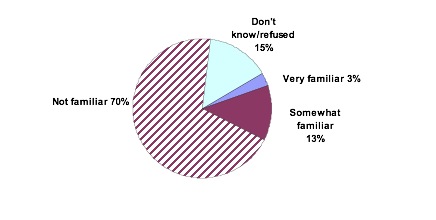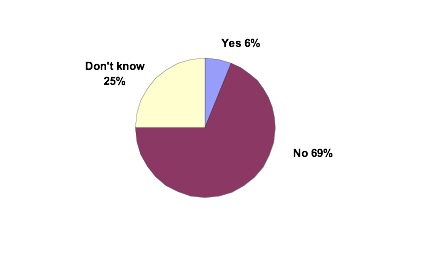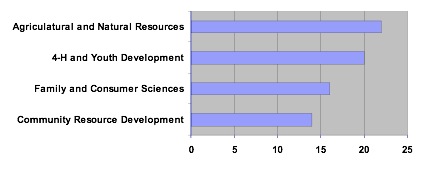December 2008 // Volume 46 // Number 6 // Feature Articles // 6FEA4
Living Well: National Extension Association of Family and Consumer Sciences National Media Campaign
Abstract
In 2000, a benchmark survey gathered information from the 18-44 age general urban population about where that group seeks Extension information and the level of the group's awareness of the Cooperative Extension Service. The information was used to develop a Family and Consumer Sciences media public relations campaign that allowed all FCS Extension agents in the U.S. to make a programming impact using the same logo, slogan, and items. The campaign has been heavily used by Extension Family and Consumer Sciences educators to educate the public about Cooperative Extension. The results have application for all components of Cooperative Extension.
Introduction
Does the general public know about Cooperative Extension and Family and Consumer Sciences programs? What do they want to learn? How will Extension Educators reach them? These questions have been circulating in the Extension system for decades. Extension has been perceived as better at carrying out effective programs than at communicating these programs to stakeholders (Warner, 1993). Members of the National Extension Association of Family and Consumer Sciences (NEAFCS) knew of these concerns and others. In August 1999, at the Joint Council of Extension Professionals (JCEP) Regional Meetings, NEAFCS led discussions concerning the future of Extension and what steps needed to be taken to find answers to these questions. This article outlines the process of developing the national public relations campaign and some of the impacts and activities that have resulted.
Telephone Survey
The discussion was continued at the NEAFCS annual session, where funds were appropriated to begin a marketing campaign to promote Extension Family and Consumer Sciences (FCS). Data was collected through a nationwide telephone survey of 530 adults, 51% female and 49% male. The majority of participants fell in the 35 to 44 age bracket (43%), while 34% of respondents were ages 25 to 34, and the remaining 23% were ages 19 to 24. This age group was selected because of the need to reach them to secure the future of Extension. On August 25-27, 2000, Fleishmann-Hillard Research, Kansas City, Missouri conducted a nationwide telephone survey of 530 younger adults to determine:
- Public awareness of the Cooperative Extension Service
- Importance of family and consumer issues to respondents
- Likelihood of taking advantage of programs offered by the Cooperative Extension Service
- Effective ways to provide respondents with information
- Previous experience with the Cooperative Extension Service
Final tabulations were weighted to reflect actual population demographics in terms of geographic region, gender, and age. Interviewing was completed by Bruskin Research as part of its Omnitel Service. The sampling error is plus or minus four percentage points at a 95% confidence level. Several of the questions related to the Cooperative Extension Service as a whole and are applicable to needs assessment and planning efforts across Extension disciplines.
Public Awareness of the Cooperative Extension Service
Survey results showed that one out of six (16%) younger adults (18 to 44 years) was familiar with the Cooperative Extension Service. As illustrated in Figure 1, 84% are unaware of the Cooperative Extension Service. A large percentage (15) either did not know how to answer the question or refused.
Figure 1.
Public Awareness of Cooperative Extension

This percentage of urban residents is significantly lower than the 45% of the general rural public who were familiar with Extension when surveyed by Warner, Christenson, Dillman, and Salant in 1995.
The NEAFCS survey of young adults also showed that few respondents knew a professional who works for the Cooperative Extension Service. As Figure 2 indicates, 6% said yes, 25% did not know, and 69% said no.
Figure 2.
Familiarity with Extension Service

In subject matter areas, younger adults (18 to 44 years) were most likely to be aware that the Cooperative Extension Service is involved in agriculture and natural resource issues. Awareness of Family and Consumer Sciences (FCS) programs was consistent with awareness of Cooperative Extension as a whole, 16%. When asked the question, "As far as you know, does your local Cooperative Extension Service deal with... 22% of the respondents were familiar with Agricultural and Natural Resources, 20% with 4-H and Youth, 16% with Family and Consumer Sciences, and 14% with Community Resource Development. See Figure 3.
Figure 3.
Discipline Identification

The 1995 survey (Warner, Christenson, Dillman, Salant, 1996) showed awareness at 50% for agriculture, 51% for home economics (Family and Consumer Sciences), 69% for 4-H, and 38% for community development. This survey indicates less awareness than the 1995 survey. The 1995 survey focused on rural areas where this survey questioned a number of urban residents.
Family and Consumer Sciences Issues
Regardless of age, survey respondents considered all of the 12 main FCS issues to be very or somewhat important. The top five Family and Consumer Sciences issues were:
- Physical Health (79%)
- Family and human relationships (78%)
- Nutrition and diet (78%)
- Financial management (77%)
- Healthy lifestyles (77%)
These five issues were also the topics chosen as "most likely to attend" when seminars or educational programs are offered by the Cooperative Extension Service.
The fact that consumers ranked so many FCS issues as nearly equal in importance may suggest they are conscious of a holistic approach to life, recognizing that healthy families are contingent on a variety of interrelated factors, from food to shelter to relationships.
Use of Family and Consumer Sciences Programming
Forty percent of survey respondents said they would be "very" or "somewhat" likely to take advantage of seminars or educational programs that are family oriented. However, this number decreased among households with higher incomes. Those most likely to take advantage of Extension education were families with household incomes less than $30,000, a demographic segment that has many educational interests such as financial management, family and human relationships, and physical health. This has important implications in Extension program planning.
Effective Ways to Provide Information
The three most effective sources of information, according to these younger adults (18 to 44 years), were television, newspaper stories, and local radio. The oldest adults (35 to 44) in the survey were more likely to have read an article about Extension in the newspaper, call Extension on the phone, or receive printed material. Men (53%) were more likely than women (42%) to have heard or seen Extension information on the radio or television.
Overall, survey respondents ranked television as the most effective source of information, followed by newspapers and radio. Local radio was most effective for respondents with income less than $20,000. About half of those surveyed had access to the Internet, but just 7% had visited an Extension Web site.
Effective sources of information varied by location. Midwesterners ranked television higher than did other geographic groups. Southerners were more likely than others to find information in public places such as malls, grocery stores, or laundry facilities.
Developing the NEAFCS Marketing Campaign
The National Extension Association of Family and Consumer Sciences could clearly see from the survey results that a marketing campaign needed to be undertaken. The profession had long talked about such a need but it was difficult to know where to start. Richard Wootton, in his Distinguished Ruby Lecture at the 2005 National Epsilon Sigma Phi meeting, spoke about the strong tradition for reliable funding from counties, states, and federal sources that have not expanded. He said, "When this reality became apparent, a very common first reaction is that more marketing of Extension is needed." After much discussion, NEAFCS members committed funds in the 2000-2001 operating budget.
A nationwide search began for media professionals to assist NEAFCS marketing efforts. Texas A & M University and Elizabeth Gregory, Texas AgriLife Extension, were contracted to work with the NEAFCS Marketing and Living Well task forces to develop a multi-pronged campaign for print, television, and radio. A logo and slogan were presented at the 2002 national meeting in Kansas City, Missouri Figures 4 & 5).
Figure 4.
Living Well Logo

Figure 5.
Slogan
Raising Kids, Eating Right, Spending Smart, Living Well
From this initial step, five English and three Spanish public service announcements (PSA) were developed for television. English and Spanish radio scripts of the Living Well PSAs were also created and distributed through the NEAFCS e-newsletter, NEAFCS Web site and at regional JCEP meetings. The topics included foods and nutrition, healthy lifestyles, food safety, family finances, and raising children. These public service announcements were distributed to every state association via CD, DVD, beta, and VHS tapes in the form of pdf files that could be localized for the county, state, or Land-Grant University. At the same time, a marketing toolkit was developed to help members use materials most effectively. Each state received copies of the Living Well public service announcements, graphics, and marketing materials.
One of the goals of the campaign was to provide a means for citizens to quickly find out how to contact their local Extension agent. The NEAFCS Marketing Committee and the University of Arizona Cooperative Extension developed the Web site www.learningandlivingwell.org so that both state and national information is available. The Web site includes pull-down links to each state Extension Web site. The planning committee decided not to develop new subject matter Web sites, but highlight existing national and state FCS subject matter sites. This Web site links to credible information in eight FCS topics: Foods and Nutrition, Healthy Lifestyles, House and Home, Food Safety, Raising Children, Family Finances, For Kids, and Balancing Work and Family.
The association has established 10 yearly $500 mini grants for the use and promotion of the Living Well campaign, and four $250 yearly Living Well Awards. These grants and awards began in 2003. Living Well freestanding booth displays were created based on the five public service advertisements. Displays were provided to each state. Many states bought additional marketing materials and have now used the logo and slogan on newsletters, news columns, and educational materials.
Accomplishments of the Living Well Campaign
The big Living Well campaign emphasis in 2003-04 was to work with federal legislators to pass a resolution for "Living Well Week" the second week of March. The Senate passed the resolution. The "Living Well Week" has provided impetus for local Extension educators to have state and local resolutions passed, to add a marketing element to programs they are doing during this time frame, and make contacts with state and local policy makers.
The Living Well campaign established a "Friend of NEAFCS" Award. The first one was presented in 2005 to Senator Chuck Grassley, Iowa, who had a significant role in getting this legislation passed.
The www.learningandlivingwell.org Web site has steadily increased in usage and had 21,481 visitors with 220,234 hits in 2007. This averages 63 hits each day. Seventy percent of the visitors went directly to the Web site based on marketing information. Only 10% of visitors were referred from search engines and the rest from other Cooperative Extension or NEAFCS Web sites. Many local counties and states have linked to www.learningandlivingwell.org Web site from their home pages.
States have embraced Living Well as a marketing strategy. Examples from the state Living Well Award winners' activities include the following.
- Southern Region-Georgia: Customized the Living Well banner display and provided one for each agent. All 42 NEAFCS members used the Living Well materials at Extension Offices, local libraries, courthouses, fairs, and other community events. They used the "Living Well Week" proclamation and created a special web site for Extension Agents to download Living Well marketing materials. The NEAFCS state president was interviewed during "Living Well Week" for a feature article on the University of Georgia's home page. The state developed PSAs that were used by 11 TV stations reaching more than 410,000 viewers. Radio listeners were exposed to the Living Well message on 42 radio stations. Living Well messages were presented in 19 newspapers across the state reaching more than 500,000 listeners. Exhibits were set up in three locations reaching 5,500 people. Information was disseminated to county employees through an Urban County Web site reaching 4,500 employees.
- Eastern Region-New Jersey: 100% of members participated to achieve the goal of statewide visibility of Living Well at the local level. The New Jersey Senate and Assembly each passed a resolution for "Living Well Week" and members received the Senate resolution in front of the full Senate. The Governor presented the resolution to NEAFCS members, which gave the event good news coverage.
- Central Region- Illinois: 158 large Living Well posters printed. Three versions of the poster were created. Each county Extension office and each NEAFCS member in Illinois received a poster to use during "Living Well Week." The Governor of Illinois signed the proclamation for "Living Well Week." One member gave out 300 breakfast bars with Living Well wrappers that were created for the weeklong promotion.
- Western Region-Alaska: Members worked together to prepare the FCS report to stakeholders, using the Living Well slogan and logo as the header in the report.
During the NEAFCS Annual Session in Philadelphia, Pennsylvania, an advertisement ran in the Sunday edition of the local newspaper to educate the public about Extension FCS and the group's presence in town. Brochures and tabletop displays, available on CD, were also made available at the meeting for states to purchase.
The Living Well logo and slogan have been used in news releases, on stationery, on pens for Extension staff and the public, on program folder labels, and some publications. The slogan and logo have been used on reports and professionally prepared PowerPoint slides to use as program openers, at intermissions, and in final slides for presentations for use by Extension staff and volunteers.
Implications and Future of Living Well
The Living Well marketing project is continuing and expanding. Other marketing items provided include:
- Expanding use of the Spanish PSAs on local television and three of the national Spanish television stations, radio, and in PowerPoint presentations for local programs.
- Continued use of the tabletop displays for fairs, community displays, and presentations.
- Taping the radio scripts with Spanish speakers and distributed a future NEAFCS national meeting.
- Press releases and brochures.
- Web site review and enhancement.
- All materials posted on the NEAFCS website for member accessibility.
- CD with Living Well marketing materials for each member at the 2006 NEAFCS national meeting.
- Pens with the Living Well logo and Web site imprinted on it were provided to NEAFCS members attending the national meeting in 2006. The pens were attached to a card with information that can be given to stakeholders with educational information about Extension Family and Consumer Sciences.
Each year a committee evaluation is done of the marketing items provided and revisions made for the following year. Each mini grant recipient submits documents looking at effectiveness and impacts of their projects. Because of the expense of a follow-up survey the association has made no plans at this point to do so. The membership has continued to believe this is making an impact and has continued to provide budgeted funds to continue. As long as the membership sees a need being met they plan to continue funds.
According to Varea-Hammond (2004), three main reasons exist for marketing Extension: political motivations, so that funding and support is gained; internal benefits, which happen when high-performance teams are created and good staff is attracted; and survival, competing for clientele who have resources available. Promotion and marketing help to enhance the impact of county Extension agents' efforts and help to maintain their presence.
Marketing attempts by counties, states, multi states, and regions for Extension have been sporadic and fractured. This is among the first organized nationwide marketing Extension Family and Consumer Sciences campaign. Extension Family and Consumer Sciences professionals have used this campaign to focus all their marketing activities to make a national impact. This is needed in all of the Extension system.
References
Fleishman-Hillard Research, Fleishman-Hillard, Inc. (2000) Consumer awareness and needs assessment a report to National Extension Association of Family and Consumer Sciences.
Irani, T., Ruth, A., Telg, R. W., & Lundy, L. K. (2006). The ability to relate: Assessing the influence of a relationship marketing strategy and message stimuli on consumer perceptions of Extension. Journal of Extension [On-line], 44(6) Article 6FEA7. Available at: http://www.joe.org/joe/2006december/a7.shtml
Telg, R., Irani, T., Hurst, A., & Kistler, M., (2007). Local marketing and promotional efforts of Florida Extension agents. Journal of Extension [On-line], 45(2) Article 2FEA5. Available at: http://www.joe.org/joe/2007April/a5p.shtml
Varea-Hammond, S. (2004). Guidebook for marketing Cooperative Extension. Journal of Extension [On-line], 42(2). Available at: http://www.joe.org/joe/2004april/tt5.shtml
Warner, P. D. (1993). It's time to tell the Extension Story. Journal of Extension [On-line], 31 (3). Available at: http://www.joe.org/joe/1993fall/tp2.html
Warner, P. D., Christenson, J. A., Dillman, D. A., & Salant, P., (1996). Public Perception of Extension. Journal of Extension [On-line], 34(4). Available at: http://www.joe.org/joe/1996august/a1.html
